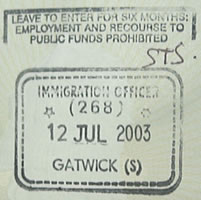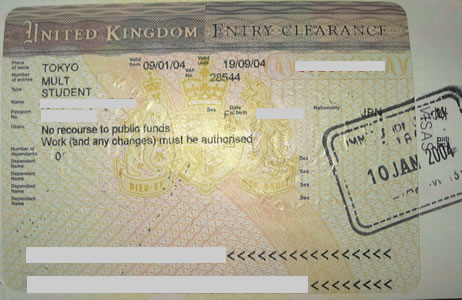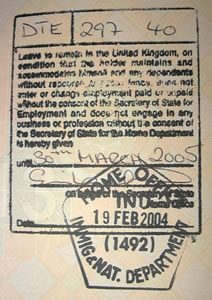- What does my passport stamp mean?
Check the stamp in your passport as soon as it has been issued. Make sure that you understand what it means. The language which is used is often complicated.
If you think that a mistake has been made, tell the immigration officer politely.
Some of the phrases you may find on your passport stamp are explained below:
Leave to enter is permission to come into the UK ("leave" means "permission" in this case)
Leave to remain is permission to stay in the UK
The holder is the owner of the passport
To enter employment means to get a job
The Secretary of State for Employment is the head of the government department which is responsible for jobs
The Secretary of State for the Home Department is the head of the Home Office (a government department)
Without recourse to public funds means without receiving money (welfare benefits) from the British government
Your passport stamp will tell you how long you can stay in the UK; for example: "leave to enter until …".
Your passport stamp will tell you if you need to register with the police soon after you have entered the UK. For example, it may say: "the holder is required to register at once with the police". Information about how to register with the police is shown in Prepare/Arrival.
Your passport stamp will also tell you if can work.
If you cannot work it might say: "leave to enter … on condition that the holder … does not enter employment paid or unpaid" or "no work".
If you can work, but only under the rules for students, it may say something like "leave to enter … on condition that the holder does not enter or change employment paid or unpaid without the consent of the Secretary of State for Employment" or "work (and any changes) must be authorised".

Visitor visa |
The visa above is an example of a
visitor visa, also known as a
tourist visa. It was issued by an immigration officer at Gatwick airport. This woman was coming to the UK to take an English language school course which lasted 3 months.
"Leave to enter for six months": she can stay for up to 6 months after the date stamped in the passport (since the stamp reads 12 July 2003, she must leave on or before 11 January 2004).
"Employment and recourse to public funds prohibited": she is not allowed to work in the UK ("employment ... prohibited") and she is not allowed to apply for any money from the British government to help her to pay for her living costs ("recourse to public funds prohibited").
In this case, the immigration officer has written the letters "STS" as a note of the fact that this person was coming as a short-term student.

Student visa (sticker/vignette) |
The visa above is a
student visa. This sticker was placed in this person's passport after he applied for a visa at the embassy in his home country (Japan), before he came to the UK. The details shown are:
Place of issue: Tokyo
Number of entries: Mult. This is an abbreviation of the word "multiple": it means that he is allowed to leave the UK and then enter the UK again as many times as he wants during the validity period of the visa.
Type: Student. This shows that this is a student visa.
Name: The student's name
Passport No: The student's passport number
Others:
"No recourse to public funds": He is not allowed to apply for any money from the British government to help her to pay for his living costs.
"Work (and any changes) must be authorised": the British Government has authorised (given permission to) people holding student visas to work part-time in the UK. This student can take a job provided that he follows the rules about the maximum number of hours he is allowed to work.
Valid from: 9 January 2004. This is the first possible date when he can enter the UK; note that the date system used is day/month/year. The stamp on the visa shows that he actually entered the UK on 10 January 2004.
Valid until: 19 September 2004. He must leave the UK before this date - unless he has obtained (or is in the process of applying for) a visa extension.

Visa extension |
The above stamp is an example of a student visa extension. It was issued by the Home Office's Immigration and Nationality Department (IND) on 19 February 2004. It reads as follows:
"Leave to remain in the United Kingdom, on condition that the holder maintains and accommodates himself and any dependents without recourse to public funds, does not enter or change employment paid or unpaid without the consent of the Secretary of State for Employment and does not engage in any business or profession without the consent of the Secretary of State for the Home Department is hereby given until 30 March 2005" (signed on behalf of the Secretary of State and the Home Office, date: 19 February 2004)
This student can stay in the UK until 30 March 2005. She can work part-time provided that the rules about working hours are followed. She is not allowed to apply for any money from the British government to help her to pay for her living costs. Note that the stamp uses the word "himself", but that this applies to either a man or a woman.